PE_WINDEX.A-O
PWS:Win32/Bzub (Microsoft), Win32/Spy.Agent.OAX trojan (ESET), Mal/Buzb-A (Sophos)
Windows


Threat Type: File infector
Destructiveness: No
Encrypted: Yes
In the wild: Yes
OVERVIEW
This file infector is embedded in an infected zip file served by a website hosted in North Korea.
To get a one-glance comprehensive view of the behavior of this File infector, refer to the Threat Diagram shown below.

This file infector may be unknowingly downloaded by a user while visiting malicious websites.
It executes commands from a remote malicious user, effectively compromising the affected system.
It deletes the initially executed copy of itself.
TECHNICAL DETAILS
Arrival Details
This file infector may be unknowingly downloaded by a user while visiting malicious websites.
Installation
This file infector drops the following copies of itself into the affected system:
- %Application Data%\Microsoft\Messenger\Extension\WdExt.exe
(Note: %Application Data% is the Application Data folder, where it usually is C:\Documents and Settings\{user name}\Application Data on Windows 2000, Windows Server 2003, and Windows XP (32- and 64-bit); C:\Users\{user name}\AppData\Roaming on Windows Vista (32- and 64-bit), Windows 7 (32- and 64-bit), Windows 8 (32- and 64-bit), Windows 8.1 (32- and 64-bit), Windows Server 2008, and Windows Server 2012.)
It injects itself into the following processes as part of its memory residency routine:
- explorer.exe
- iexplore.exe
- ieuser.exe
- firefox.exe
- chrome.exe
- msimn.exe
- outlook.exe
- winmail.exe
- msnmsgr.exe
- yahoomessenger.exe
- ftp.exe
Autostart Technique
This file infector adds the following registry entries to enable its automatic execution at every system startup:
HKEY_CURRENT_USER\Software\Microsoft\
Windows\CurrentVersion\Run
Windows Defender Extension = "%Application Data%\Microsoft\Defender\launch.exe"
Backdoor Routine
This file infector executes the following commands from a remote malicious user:
- Execute remote shell
- List processes
- List files and folders
- Download and execute file
- Upload file
- Capture Screenshots of affected system
It connects to the following URL(s) to send and receive commands from a remote malicious user:
- http://a.{BLOCKED}perl.sh
- http://a-{BLOCKED}-01.slyip.net
- http://{BLOCKED}was-01.dyndns.org
It posts the following information to its command and control (C&C) server:
- Date and Time(UTC)
- Computer Name
- Username
- OS Information
- MAC Address
- IP Address and Subnet Mask
- Adapter Information
- Network (Internet | Closed)
- TTL \ Hop Limit
- Network Type (LAN | RAS | PROXY | MODEM | OFFLINE)
Dropping Routine
This file infector drops the following files:
- %Application Data%Microsoft\Caches\Files\usd.dll
- %Application Data%\Microsoft\Common\Shared\dis.dll
- %Application Data%\Microsoft\Identities\{computer name}\arc.dll
- %Application Data%\Microsoft\Repairs\sha.dll
- %Application Data%\Microsoft\Shared\Modules\fil.dll
- %Application Data%\Microsoft\Windows\Addins\att.dll
- %Application Data%\Microsoft\Defender\launch.exe
- %System%\wtime32.dll
- %System%\mscaps.exe
(Note: %Application Data% is the Application Data folder, where it usually is C:\Documents and Settings\{user name}\Application Data on Windows 2000, Windows Server 2003, and Windows XP (32- and 64-bit); C:\Users\{user name}\AppData\Roaming on Windows Vista (32- and 64-bit), Windows 7 (32- and 64-bit), Windows 8 (32- and 64-bit), Windows 8.1 (32- and 64-bit), Windows Server 2008, and Windows Server 2012.. %System% is the Windows system folder, where it usually is C:\Windows\System32 on all Windows operating system versions.)
Other Details
This file infector connects to the following URL(s) to check for an Internet connection:
- http://windowsupdate.microsoft.com
It deletes the initially executed copy of itself
NOTES:
It disables the Windows error notification functionality.
It infects .exe files in shared folders and removable drives.
It adds the following registry keys to setup its persistence mechanism:
HKEY_LOCAL_MACHINE\SOFTWARE\Microsoft\Active Setup\Installed Components\{ef2b00e3-19da-4e78-b118-6b6451b719f2}
StubPath = ""%System%\mscaps.exe" /s /n /i:U shell32.dll"
ComponentID = "DirectShow"
Version = "1,125,2406,1"
Locale = "*"
SOLUTION
Step 1
Before doing any scans, Windows XP, Windows Vista, and Windows 7 users must disable System Restore to allow full scanning of their computers.
Step 2
Restart in Safe Mode
Step 3
Delete this registry key
Important: Editing the Windows Registry incorrectly can lead to irreversible system malfunction. Please do this step only if you know how or you can ask assistance from your system administrator. Else, check this Microsoft article first before modifying your computer's registry.
- HKEY_LOCAL_MACHINE\SOFTWARE\Microsoft\Active Setup\Installed Components\{ef2b00e3-19da-4e78-b118-6b6451b719f2}
Step 4
Delete this registry value
Important: Editing the Windows Registry incorrectly can lead to irreversible system malfunction. Please do this step only if you know how or you can ask assistance from your system administrator. Else, check this Microsoft article first before modifying your computer's registry.
- In HKEY_CURRENT_USER\Software\Microsoft\Windows\CurrentVersion\Run
- Windows Defender Extension = "%Application Data%\Microsoft\Defender\launch.exe"
- Windows Defender Extension = "%Application Data%\Microsoft\Defender\launch.exe"
Step 5
Search and delete this file
- %Application Data%\Microsoft\Messenger\Extension\WdExt.exe
- %Application Data%Microsoft\Caches\Files\usd.dll
- %Application Data%\Microsoft\Common\Shared\dis.dll
- %Application Data%\Microsoft\Identities\{computer name}\arc.dll
- %Application Data%\Microsoft\Repairs\sha.dll
- %Application Data%\Microsoft\Shared\Modules\fil.dll
- %Application Data%\Microsoft\Windows\Addins\att.dll
- %Application Data%\Microsoft\Defender\launch.exe
- %System%\wtime32.dll
- %System%\mscaps.exe
Step 6
Restart in normal mode and scan your computer with your Trend Micro product for files detected as PE_WINDEX.A-O. If the detected files have already been cleaned, deleted, or quarantined by your Trend Micro product, no further step is required. You may opt to simply delete the quarantined files. Please check this Knowledge Base page for more information.
Did this description help? Tell us how we did.

